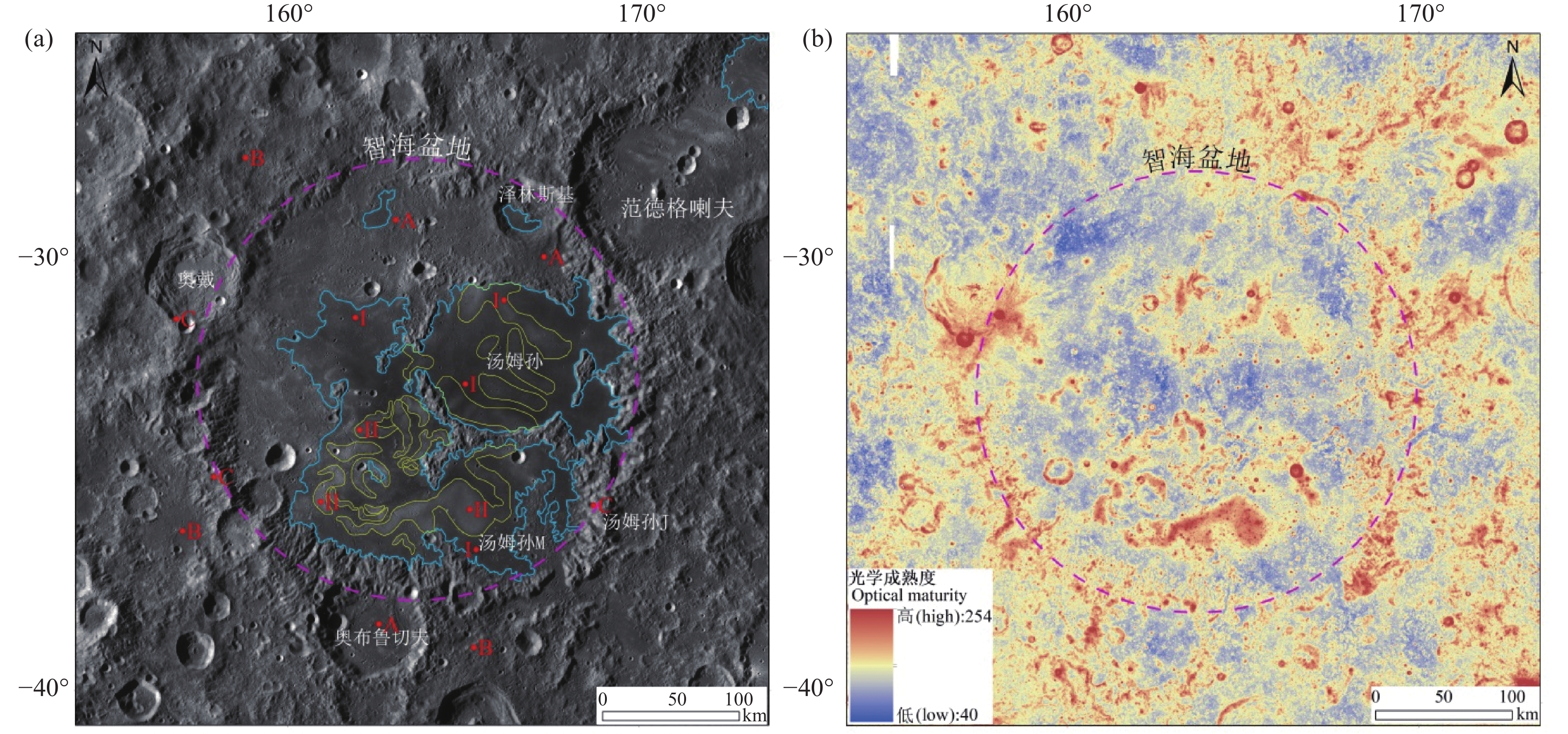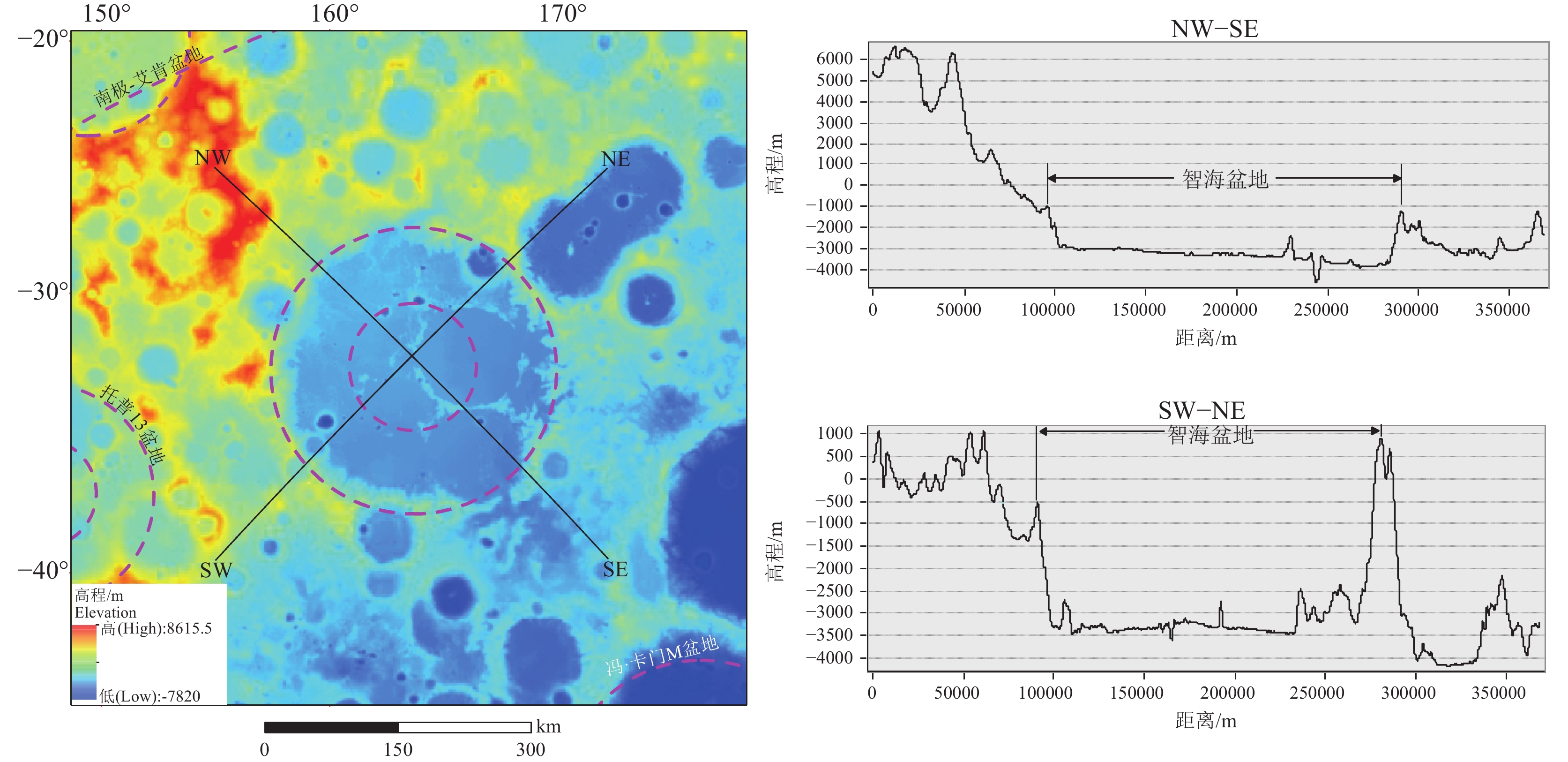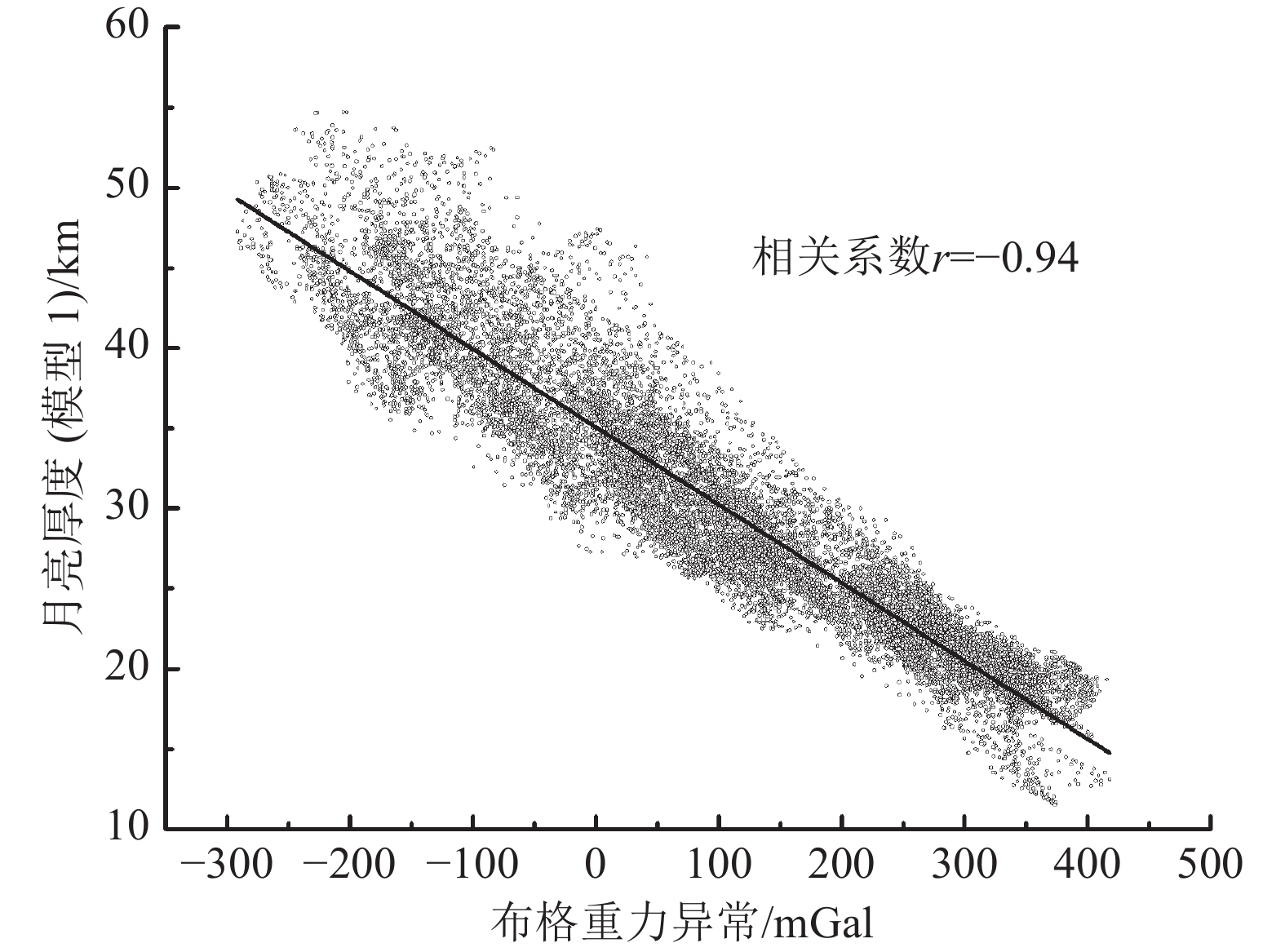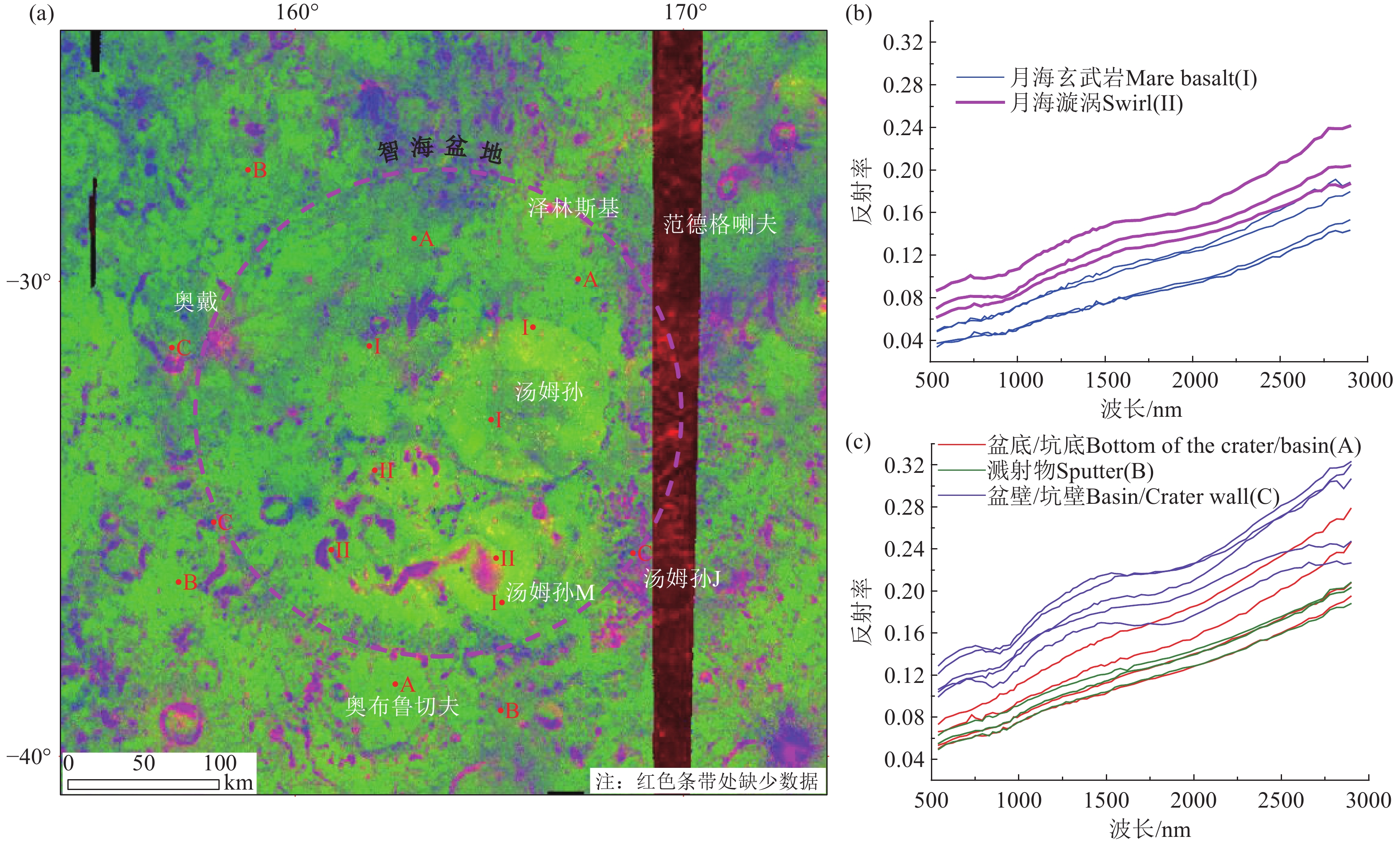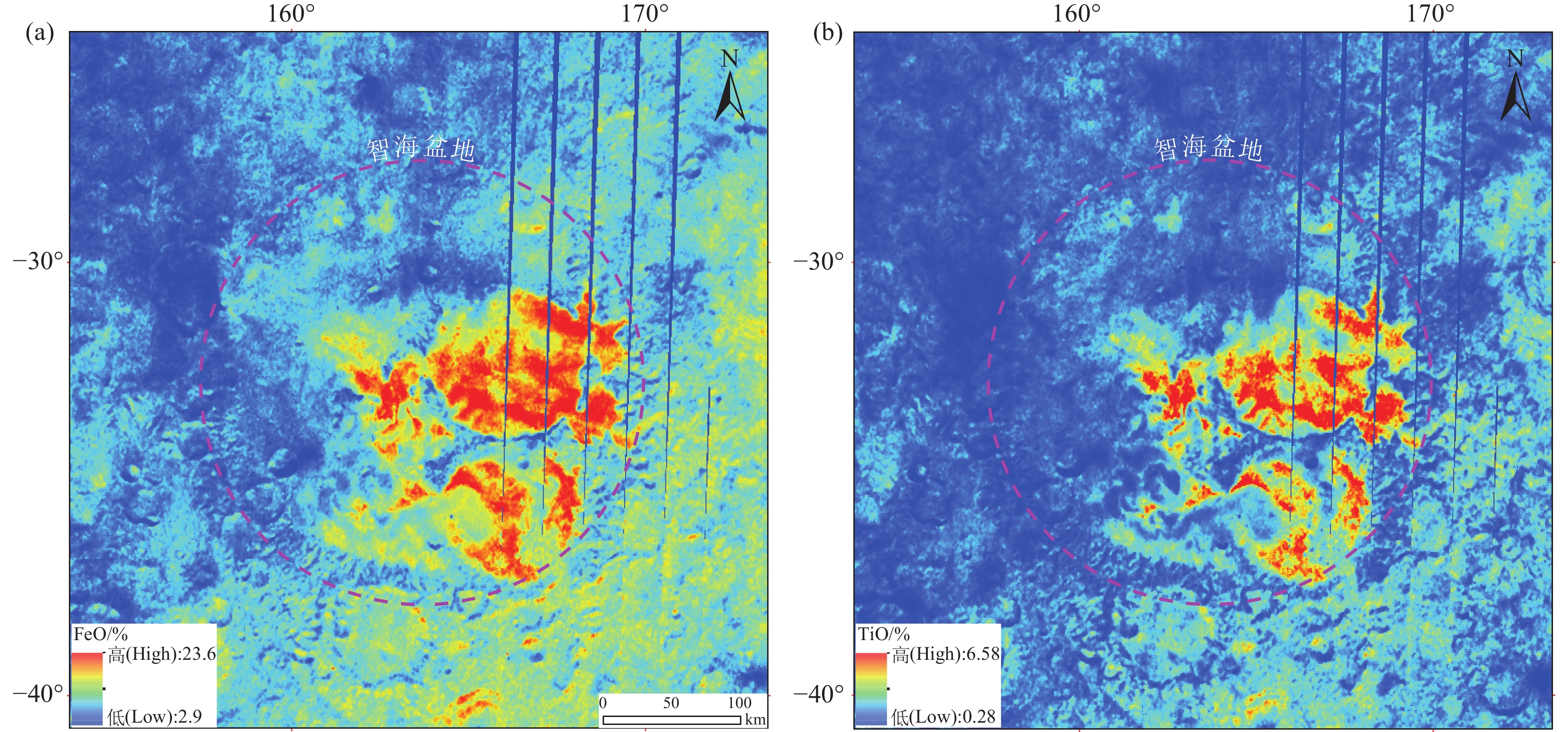Characteristics analysis and evolution model of Ingenii Basin on the Moon based on multisource remote sensing data
-
摘要:
研究目的 月海撞击盆地是月表最重要的地质单元之一,其地质演化特征受内、外动力地质作用的综合影响。古老的智海盆地位于月球背面南极—艾肯(South Pole−Aitken, SPA)盆地内的西北部边界位置,这一特殊的地理位置使其对于认识月球结构与成分、内外动力地质作用演化过程具有重要意义。
研究方法 本文从可见光影像、月壤成熟度、地形、坡度、粗糙度等表面特征,布格重力异常、月壳厚度等深部特征以及元素、矿物丰度等物质特征多个维度对智海盆地进行综合解析。
研究结果 智海盆地区域具有极不对称性,其内部地形呈西北高东南低的特征,发育奇特的漩涡月貌,除漩涡与陡峭的盆壁及撞击坑壁区域外普遍具有较高的月壤成熟度。形成智海盆地的巨大撞击作用引起高密度月幔岩石圈隆起,导致盆地中央表现重力正异常,对应的月壳厚度也最薄。月壳厚度与布格重力异常之间具有线性反比关系,相关系数r为−0.94。盆地内部月海玄武岩充填区相比邻区具有高铁、高钛特征,智海以外区域的物质成分特征普遍与撞击靶区相近。在对智海盆地表面特征、深部特征及物质成分等多个维度特征进行解析的基础上,完成智海盆地区域地质演化模式分析。
结论 智海盆地的地貌与成分受到内、外动力地质作用的综合影响,表现出南极—艾肯地体和长石质高地地体的双重特征,是理解月球早期演化历史的一个窗口。
Abstract:This paper is the result of moon geological survey engineering.
Objective Mare basins constitute pivotal geological units on the lunar surface. Their geological evolution characteristics are comprehensively affected by both endogenic and exogenic dynamic geological processes. The ancient Ingenii Basin is located on the northwest rim of South Pole−Aitken Basin on the lunar farside. This special geographical location endows it with great significance for understanding lunar structure, composition, and the evolution of these dynamic geological processes.
Methods This study conducts a comprehensive and multi−faceted analysis of Ingenii Basin, encompassing surface attributes like albedo variations, soil maturity indices, topography, slope gradients, and roughness, alongside deep−seated features such as Bouguer gravity anomalies, crustal thickness, and compositional characteristics in elemental and mineral abundances.
Results The region of Ingenii Basin exhibits pronounced asymmetry, with a topographic profile characterized by elevated northwest regions and lower−lying southeast areas. Distinctive swirl patterns adorn the basin. The majority of the terrain, excluding swirls, steep basin walls, and impact crater walls, generally displays high maturity. The Ingenii Basin−forming impact event uplifted high−density mantle materials beneath the Moho surface, resulting in a positive gravity anomaly at the basin’s center, where the crustal thickness attains its minimum. A linear inverse correlation emerges between crust thickness and Bouguer gravity anomalies, particularly pronounced for gravity anomalies exceeding 200 mGal. Within the basin’s mare basalt regions, FeO and TiO2 abundances are elevated, while compositional traits outside the Ingenii region generally mirror those of the impacted target. Through a multi−dimensional examination of surface, subsurface, and compositional features, we delineated the regional geological evolution mode of Ingenii Basin.
Conclusions The landform and composition of the Ingenii Basin are comprehensively affected by endogenic and exogenic dynamic geological processes, exhibiting the dual characteristics of the South Pole − Aitken Terrane and the Feldspathic Highlands Terrane, which is a window to understand the early evolutionary history of the Moon.
-

-
图 5 智海盆地区域布格重力异常图(a)、模型1的月壳厚度图(b)、模型4的月壳厚度图(c)(Wieczorek et al.,2013)
Figure 5.
图 12 SPA盆地内月海玄武岩单元模式年龄(据Chen et al., 2022b修改)
Figure 12.
-
[1] Che X C, Nemchin A, Liu D Y, Long T, Wang C, Norman M D, Joy K H, Tartese R, Head J W, Jolliff B, Snape J F, Neal C R, Whitehouse M J, Crow C, Benedix G, Jourdan F, Yang Z Q, Yang C, Liu J H, Xie S W, Bao Z M, Fan R L, Li D P, Li Z S, Webb T G. 2021. Age and composition of young basalts on the Moon, measured from samples returned by Chang’e−5[J]. Science, 374: 887−890. doi: 10.1126/science.abl7957
[2] Chen J, Ling Z C, Jolliff BL, Sun L Z, Qiao L, Liu J Z, Fu X H, Zhang J, Li B, Liu C Q, Qi X B, Lu X J, He Z P, Xu R. 2022a. Radiative Transfer Modeling of Chang'e−4 spectroscopic observations and interpretion of the South Pole−Aitken compositional anomaly[J]. The Astrophysical Journal Letters, 931: 1−15. doi: 10.3847/1538-4357/ac6876
[3] Chen J, Ling Z C, Liu J Z, Chen S B, Ding X Z, Chen J P, Cheng W M, Li B, Zhang J, Sun L Z. 2022b. Digital and global lithologic mapping of the Moon at a 1: 2, 500, 000 scale[J]. Science Bulletin, 67: 2050−2054. doi: 10.1016/j.scib.2022.09.015
[4] Domingue D, Weirich J, Chuang F, Sickafoose A, Palmer E. 2022. Topographic correlations within Lunar swirls in Mare Ingenii[J]. Geophysical Research Letters, 49: e2021GL095285. doi: 10.1029/2021GL095285
[5] Du Jinsong, Liang Qing, Chen Chao, Zhou Cong, Chen Bo. 2010. Deep structure and impact evolution of lunar mascon basins[J]. Geological Science and Technology Information, 29(5): 134−142 (in Chinese with English abstract).
[6] Glotch T D, Bandfield J L, Lucey P G, Hayne P O, Greenhagen B T, Arnold J A, Ghent R R, Paige D A. 2015. Formation of lunar swirls by magnetic field standoff of the solar wind[J]. Nature Communications, 6: 6189. doi: 10.1038/ncomms7189
[7] Gou S, Yue Z Y, Di K C, Wang J, Wan W H, Liu Z Q, Liu B, Peng M. 2020. Impact melt breccia and surrounding regolith measured by Chang’e−4 rover[J]. Earth and Planetary Science Letters, 544: 116378. doi: 10.1016/j.jpgl.2020.116378
[8] Guo, D J, Liu J Z, Head J W, Zhang F Q, Ling Z C, Chen S B, Chen J P, Ding X Z, Ji J Z, Ouyang ZY. 2024. A lunar time scale from the perspective of the Moon’s dynamic evolution[J]. Science China Earth Sciences, 67(1): 234−251. doi: 10.1007/s11430-022-1183-4
[9] Guo Dijun, Liu Jianzhong, Zhang Li, Ji Jinzhu, Liu Jingwen, Wang Liang. 2014. The methods of lunar geochronology study and the subdivisions of lunar geologic history[J]. Earth Science Frontiers, 21(6): 45−61 (in Chinese with English abstract).
[10] Guo Dijun, Liu Jianzhong, Head J W, Li Shuai, Potter R W K, Lin Honglei. 2018. Crustal structure and spectral features of lunar Apollo basin region[J]. Journal of Deep Space Exploration, 5(5): 488−494 (in Chinese with English abstract).
[11] Hiesinger H, Jaumann R, Neukum G, Head J W. 2000. Ages of mare basalts on the lunar nearside[J]. Journal of Geophysical Research−Planets, 105: 29239−29275. doi: 10.1029/2000JE001244
[12] Hanna K L D, Cheek L C, Pieters C M, Mustard J F, Greenhagen B T, Thomas I R and Bowles N E. 2014. Global assessment of pure crystalline plagioclase across the Moon and implications for the evolution of the primary crust[J]. Journal of Geophysical Research−Planets, 119: 1516−1545. doi: 10.1002/2013JE004476
[13] Huang J, Xiao Z Y, Xiao L, Horgan B, Hu X Y, Lucey P, Xiao X, Zhao S Y, Qian Y Q, Zhang H, Li C L, Xu R, He Z P, Yang J F, Xue B, He Q, Zhong J, Lin G Y, Huang C N, Xie J F. 2020. Diverse rock types detected in the lunar South Pole–Aitken Basin by the Chang’E−4 lunar mission[J]. Geology, 48: 723−727.
[14] Hurwitz D, Kring D A. 2015. Potential sample sites for South Pole–Aitken basin impact melt within the Schrödinger basin[J]. Earth and Planetary Science Letters, 427: 31−36. doi: 10.1016/j.jpgl.2015.06.055
[15] Ji Jinzhu, Liu Jianzhong, Guo Dijun, Liu Jingwen, Wang Qinglong, Zhang li. 2016. Impact basin of Mare Nubium: Reconstruction and geological evolution[J]. Acta Petrologica Sinica, 32(1): 127−134 (in Chinese with English abstract).
[16] Jia M N, Di K C, Yue Z Y, Liu B, Wan W H, Niu S L, Liu J Z, Cheng W M, Lin Y T. 2021. Multi−scale morphologic investigation of craters in the Chang'e−4 landing area[J]. Icarus, 355: 114164. doi: 10.1016/j.icarus.2020.114164
[17] Kramer G Y, Combe J P, Harnett E M, Hawke B R, Noble S K, Blewett D T, McCord T B, Giguere T A. 2011. Characterization of lunar swirls at Mare Ingenii: A model for space weathering at magnetic anomalies[J]. Journal of Geophysical Research Planets, 116: E04008.
[18] Kramer G Y, Kring D A, Nahm A L, Pieters C M. 2013. Spectral and photogeologic mapping of Schrödinger Basin and implications for post−South Pole−Aitken impact deep subsurface stratigraphy[J]. Icarus, 223: 131−148. doi: 10.1016/j.icarus.2012.11.008
[19] Lemelin M, Lucey P G, Gaddis L R, Hare T, Ohtake M. 2016. Global map products from the kaguya multiband imager at 512 ppd: minerals, FeO, and OMAT[C]//47th Lunar and Planetary Science Conference.
[20] Li Q L, Zhou Q, Liu Y, Xiao Z Y, Lin Y T, Li J H, Ma H X, Tang G Q, Guo S, Tang X, Yuan J Y, Li J, Wu F Y, Ouyang Z Y, Li C L, Li X H. 2021. Two−billion−year−old volcanism on the Moon from Chang’e−5 basalts[J]. Nature, 600: 54−58. doi: 10.1038/s41586-021-04100-2
[21] Lin H L, He Z P, Yang W, Lin Y T, Xu R, Zhang C, Zhu M H, Chang R, Zhang J H, Li C L, Lin H Y, Liu Y, Gou S, Wei Y, Hu S, Xue Chang, Yang Jian, Zhong J, Fu X H, Wan W X, Zou Y L. 2020. Olivine−norite rock detected by the lunar rover Yutu−2 likely crystallized from the SPA−impact melt pool[J]. National Science Review, 7: 913−920. doi: 10.1093/nsr/nwz183
[22] Liu Jingwen, Liu Jianzhong, Guo Dijun, Ji Jinzhu, Wang Qinglong, Li Shijie. 2016. Comprehensive analysis of lunar Orientale Basin and research of the initial impact condition[J]. Acta Petrologica Sinica, 32(1): 135−143(in Chinese with English abstract).
[23] Lu Tianqi. 2020. Study on Remote Sensing Recognition and Evolution of Lunar Tectonics[D]. Changchun: Jilin University, 1−172.
[24] Maria Z T, David S E. 1994. The shape and internal structure of the moon from the Clementine mission[J]. Science, 266: 1839−1843. doi: 10.1126/science.266.5192.1839
[25] Ohtake M, Matsunaga T, Haruyama J, Yokota Y, Morota T, Honda C, Ogawa Y, Torii M, Miyamoto H, Arai T, Hirata N, Iwasaki A. 2009. The global distribution of pure anorthosite on the Moon[J]. Nature, 461: 236−240. doi: 10.1038/nature08317
[26] Ouyang Ziyuan, Liu Jianzhong. 2014. The origin and evolution of the Moon and its geological mapping[J]. Earth Science Frontiers, 21(6): 1−6 (in Chinese with English abstract).
[27] Pieters C M, Hanna K D, Cheek L, Dhingra D, Prissel T, Jackson C, Taylor L A. 2014. The distribution of Mg−spinel across the Moon and constraints on crustal origin[J]. American Mineralogist, 99: 1893−1910. doi: 10.2138/am-2014-4776
[28] Potter R W K, Head J W, Guo D J, Liu J Z, Xiao L. 2018. The Apollo Peak−Ring Impact Basin: Insights into the structure and evolution of the South Pole−Aitken Basin[J]. Icarus, 306: 139−149. doi: 10.1016/j.icarus.2018.02.007
[29] Smith D E, Zuber M T, Neumann G A, Lemoine F G, Mazarico E, Torrence M H, McGarry J F, Rowlands D D, Head J W, Duxbury T H, Aharonson O, Lucey P G, Robinson M S, Barnouin O S, Cavanaugh J F, Sun X L, Liiva P, Mao D D, Smith J C, Bartels . E. 2010. Initial observations from the Lunar Orbiter Laser Altimeter (LOLA) [J]. Geophysical Research Letters, 37: L18204.
[30] Sun Y, Li L, Zhang Y Z. 2017. Detection of Mg−spinel bearing central peaks using M3 images: Implications for the petrogenesis of Mg−spinel[J]. Earth and Planetary Science Letters, 465: 48−58.
[31] Wang Liang, Ding Xiaozhong, Han Kunying, Pang Jianfeng, Xu Kejuan, Zheng Hongwei, Wu Hao. 2015. The compilation of the lunar digital geological map and a discussion on the tectonic evolution of the moon[J]. Geology in China, 42(1): 331−341 (in Chinese with English abstract).
[32] Wieczorek M A, Neumann G A, Nimmo F, Kiefer W S, Taylor G J, Melosh H J, Phillips R J, Solomon S C, Andrews−Hanna J C, Asmar S W. 2013. The Crust of the Moon as seen by GRAIL[J]. Science, 339: 671−675. doi: 10.1126/science.1231530
[33] Wieczorek M A, Phillips R J. 1998. Potential anomalies on a sphere: Applications to the thickness of the lunar crust[J]. Journal of Geophysical Research−Planets, 103: 1715−1724. doi: 10.1029/97JE03136
[34] Yamamoto S, Nakamura R, Matsunaga T, Ogawa Y, Ishihara Y, Morota T, Hirata N, Ohtake M, Hiroi T, Yokota Y, Haruyama J. 2012. Massive layer of pure anorthosite on the Moon[J]. Geophysical Research Letters, 39: 34−47.
[35] Xu Yingkui, Zhu Dan, Wang Shijie, Liu Yun. 2012. Recent advances of lunar formation theories[J]. Bulletin of Mineralogy, Petrology and Geochemistry, 31(5): 516−521(in Chinese with English abstract).
[36] 杜劲松, 梁青, 陈超, 周聪, 陈波. 2010. 月球“质量瘤”盆地的深部结构与撞击演化[J]. 地质科技情报, 29(5): 134−142.
[37] 郭弟均, 刘建忠, Head J W, 李帅, Potter R W K, 林红磊. 2018. 月球阿波罗盆地区域月壳结构及光谱特征[J]. 深空探测学报, 5(5): 488−494.
[38] 郭弟均, 刘建忠, 张莉, 籍进柱, 刘敬稳, 王梁. 2014. 月球地质年代学研究方法及月面历史划分[J]. 地学前缘, 21(6): 45−61.
[39] 籍进柱, 刘建忠, 郭弟均, 刘敬稳, 王庆龙, 张莉. 2015. 云海撞击盆地的恢复及其地质演化研究[J]. 岩石学报, 32(1): 127−134.
[40] 刘敬稳, 刘建忠, 郭弟均, 籍进柱, 王庆龙, 李世杰. 2016. 月球东海盆地综合解析与撞击初始条件的研究[J]. 岩石学报, 32(1): 135−143.
[41] 陆天启. 2020. 月球构造遥感识别及其演化研究[D]. 长春: 吉林大学, 1−172.
[42] 欧阳自远, 刘建忠. 2014. 月球形成演化与月球地质图编研[J]. 地学前缘, 21(6): 1−6.
[43] 王梁, 丁孝忠, 韩坤英, 庞健峰, 许可娟, 郑洪伟, 吴昊. 2015. 月球数字地质图的编制与研究[J]. 中国地质, 42(1): 331−341.
[44] 许英奎, 朱丹, 王世杰, 刘耘. 2012. 月球起源研究进展[J]. 矿物岩石地球化学通报, 31(5): 516−521. doi: 10.3969/j.issn.1007-2802.2012.05.011
-




 下载:
下载:
